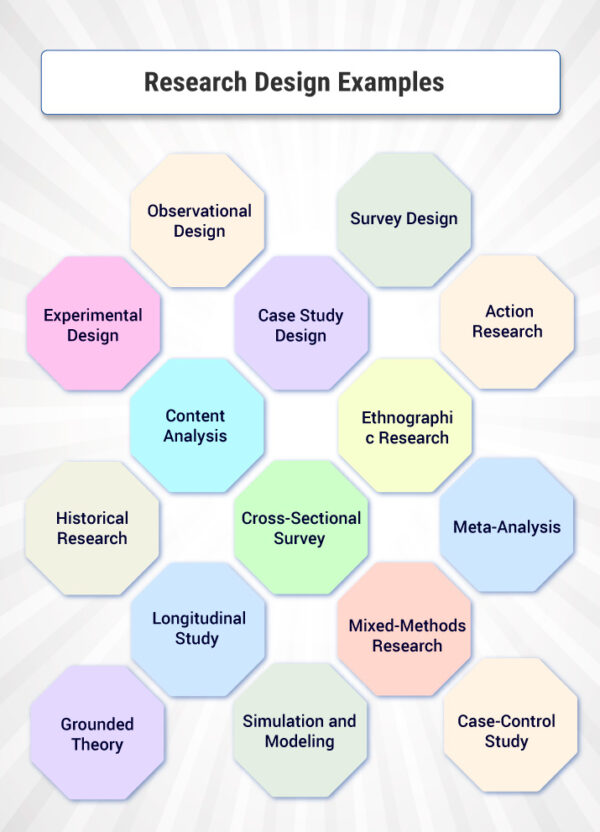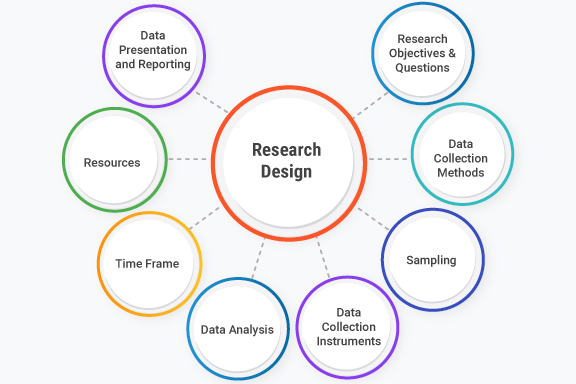What is a Research Design?
A research design is defined as the overall plan or structure that guides the process of conducting research. It is a critical component of the research process and serves as a blueprint for how a study will be carried out, including the methods and techniques that will be used to collect and analyze data. A well-designed research study is essential for ensuring that the research objectives are met and that the results are valid and reliable.
Key elements of research design include:
- Research Objectives: Clearly define the goals and objectives of the research study. What is the research trying to achieve or investigate?
- Research Questions or Hypotheses: Formulating specific research questions or hypotheses that address the objectives of the study. These questions guide the research process.
- Data Collection Methods: Determining how data will be collected, whether through surveys, experiments, observations, interviews, archival research, or a combination of these methods.
- Sampling: Deciding on the target population and selecting a sample that represents that population. Sampling methods can vary, such as random sampling, stratified sampling, or convenience sampling.
- Data Collection Instruments: Developing or selecting the tools and instruments needed to collect data, such as questionnaires, surveys, or experimental equipment.
- Data Analysis: Defining the statistical or analytical techniques that will be used to analyze the collected data. This may involve qualitative or quantitative methods, depending on the research goals.
- Time Frame: Establishing a timeline for the research project, including when data will be collected, analyzed, and reported.
- Ethical Considerations: Addressing ethical issues, including obtaining informed consent from participants, ensuring the privacy and confidentiality of data, and adhering to ethical guidelines.
- Resources: Identifying the resources needed for the research, including funding, personnel, equipment, and access to data sources.
- Data Presentation and Reporting: Planning how the research findings will be presented and reported, whether through written reports, presentations, or other formats.
There are various research designs, such as experimental, observational, survey, case study, and longitudinal designs, each suited to different research questions and objectives. The choice of research design depends on the nature of the research and the goals of the study.
A well-constructed research design is crucial because it helps ensure the validity, reliability, and generalizability of research findings, allowing researchers to draw meaningful conclusions and contribute to the body of knowledge in their field.
10 Types of Research Design
Understanding the intricate tapestry of research design is pivotal for steering your investigations toward unparalleled success. Dive deep into the realm of methodologies, where precision meets impact, and craft tailored approaches to illuminate every research endeavor.
1. Experimental Research Design: Mastering Controlled Trials
Delve into the heart of experimentation with Randomized Controlled Trials (RCTs). By randomizing participants into experimental and control groups, RCTs meticulously assess the efficacy of interventions or treatments, establishing clear cause-and-effect relationships.
2. Quasi-Experimental Research Design: Bridging the Gap Ethically
When randomness isn’t feasible, embrace the pragmatic alternative of Non-equivalent Group Designs. These designs allow ethical comparison across multiple groups without random assignment, ensuring robust research conduct.
3. Observational Research Design: Capturing Real-world Dynamics
Capture snapshots of reality with Cross-Sectional Studies, unraveling intricate relationships and disparities between variables in a single moment. Embark on longitudinal journeys with Longitudinal Studies, tracking evolving trends and patterns over time.
4. Descriptive Research Design: Unveiling Insights Through Data
Plunge into the depths of data collection with Survey Research, extracting insights into attitudes, characteristics, and opinions. Engage in profound exploration through Case Studies, dissecting singular phenomena to unveil profound insights.
5. Correlational Research Design: Navigating Interrelationships
Traverse the realm of correlations with Correlational Studies, scrutinizing interrelationships between variables without inferring causality. Uncover insights into the dynamic web of connections shaping research landscapes.
6. Ex Post Facto Research Design: Retroactive Revelations
Explore existing conditions retrospectively with Retrospective Exploration, shedding light on potential causes where variable manipulation isn’t feasible. Uncover hidden insights through meticulous retrospective analysis.
7. Exploratory Research Design: Pioneering New Frontiers
Initiate your research odyssey with Pilot Studies, laying the groundwork for comprehensive investigations while refining research procedures. Blaze trails into uncharted territories and unearth groundbreaking discoveries.
8. Cohort Study: Chronicling Evolution
Embark on longitudinal expeditions with Cohort Studies, monitoring cohorts to elucidate the evolution of specific outcomes over time. Witness the unfolding narrative of change and transformation.
9. Action Research: Driving Practical Solutions
Collaboratively navigate challenges with Action Research, fostering improvements in educational or organizational settings. Drive meaningful change through actionable insights derived from collaborative endeavors.
10. Meta-Analysis: Synthesizing Knowledge
Combine perspectives gleaned from various studies through Meta-Analyses, providing a comprehensive panorama of research discoveries.
By honing in on the nuances of each research design and aligning your content with strategic SEO principles, you can ascend to the zenith of search engine rankings and establish your authority in the domain of research methodology.
Learn more: What is Research?
Top 16 Research Design Methods
Research design methods refer to the systematic approaches and techniques used to plan, structure, and conduct a research study. The choice of research design method depends on the research questions, objectives, and the nature of the study. Here are some key research design methods commonly used in various fields:
1. Experimental Method
Controlled Experiments: In controlled experiments, researchers manipulate one or more independent variables and measure their effects on dependent variables while controlling for confounding factors.
2. Observational Method
Naturalistic Observation: Researchers observe and record behavior in its natural setting without intervening. This method is often used in psychology and anthropology.
Structured Observation: Observations are made using a predetermined set of criteria or a structured observation schedule.
3. Survey Method
Questionnaires: Researchers collect data by administering structured questionnaires to participants. This method is widely used for collecting quantitative research data.
Interviews: In interviews, researchers ask questions directly to participants, allowing for more in-depth responses. Interviews can take on structured, semi-structured, or unstructured formats.
4. Case Study Method
Single-Case Study: Focuses on a single individual or entity, providing an in-depth analysis of that case.
Multiple-Case Study: Involves the examination of multiple cases to identify patterns, commonalities, or differences.
5. Content Analysis
Researchers analyze textual, visual, or audio data to identify patterns, themes, and trends. This method is commonly used in media studies and social sciences.
6. Historical Research
Researchers examine historical documents, records, and artifacts to understand past events, trends, and contexts.
7. Action Research
Researchers work collaboratively with practitioners to address practical problems or implement interventions in real-world settings.
8. Ethnographic Research
Researchers immerse themselves in a particular cultural or social group to gain a deep understanding of their behaviors, beliefs, and practices.
9. Cross-sectional and Longitudinal Surveys
Cross-sectional surveys collect data from a sample of participants at a single point in time.
Longitudinal surveys collect data from the same participants over an extended period, allowing for the study of changes over time.
10. Meta-Analysis
Researchers conduct a quantitative synthesis of data from multiple studies to provide a comprehensive overview of research findings on a particular topic.
11. Mixed-Methods Research
Combines qualitative and quantitative research methods to provide a more holistic understanding of a research problem.
12. Grounded Theory
A qualitative research method that aims to develop theories or explanations grounded in the data collected during the research process.
13. Simulation and Modeling
Researchers use mathematical or computational models to simulate real-world phenomena and explore various scenarios.
14. Survey Experiments
Combines elements of surveys and experiments, allowing researchers to manipulate variables within a survey context.
15. Case-Control Studies and Cohort Studies
These epidemiological research methods are used to study the causes and risk factors associated with diseases and health outcomes.
16. Cross-Sequential Design
Combines elements of cross-sectional and longitudinal research to examine both age-related changes and cohort differences.
The selection of a specific research design method should align with the research objectives, the type of data needed, available resources, ethical considerations, and the overall research approach. Researchers often choose methods that best suit the nature of their study and research questions to ensure that they collect relevant and valid data.
Learn more: What is Research Objective?
Research Design Examples

Research designs can vary significantly depending on the research questions and objectives. Here are some examples of research designs across different disciplines:
- Experimental Design: A pharmaceutical company conducts a randomized controlled trial (RCT) to test the efficacy of a new drug. Participants are randomly assigned to two groups: one receiving the new drug and the other a placebo. The company measures the health outcomes of both groups over a specific period.
- Observational Design: An ecologist observes the behavior of a particular bird species in its natural habitat to understand its feeding patterns, mating rituals, and migration habits.
- Survey Design: A market research firm conducts a survey to gather data on consumer preferences for a new product. They distribute a questionnaire to a representative sample of the target population and analyze the responses.
- Case Study Design: A psychologist conducts a case study on an individual with a rare psychological disorder to gain insights into the causes, symptoms, and potential treatments of the condition.
- Content Analysis: Researchers analyze a large dataset of social media posts to identify trends in public opinion and sentiment during a political election campaign.
- Historical Research: A historian examines primary sources such as letters, diaries, and official documents to reconstruct the events and circumstances leading up to a significant historical event.
- Action Research: A school teacher collaborates with colleagues to implement a new teaching method in their classrooms and assess its impact on student learning outcomes through continuous reflection and adjustment.
- Ethnographic Research: An anthropologist lives with and observes an indigenous community for an extended period to understand their culture, social structures, and daily lives.
- Cross-Sectional Survey: A public health agency conducts a cross-sectional survey to assess the prevalence of smoking among different age groups in a specific region during a particular year.
- Longitudinal Study: A developmental psychologist follows a group of children from infancy through adolescence to study their cognitive, emotional, and social development over time.
- Meta-Analysis: Researchers aggregate and analyze the results of multiple studies on the effectiveness of a specific type of therapy to provide a comprehensive overview of its outcomes.
- Mixed-Methods Research: A sociologist combines surveys and in-depth interviews to study the impact of a community development program on residents’ quality of life.
- Grounded Theory: A sociologist conducts interviews with homeless individuals to develop a theory explaining the factors that contribute to homelessness and the strategies they use to cope.
- Simulation and Modeling: Climate scientists use computer models to simulate the effects of various greenhouse gas emission scenarios on global temperatures and sea levels.
- Case-Control Study: Epidemiologists investigate a disease outbreak by comparing a group of individuals who contracted the disease (cases) with a group of individuals who did not (controls) to identify potential risk factors.
These examples demonstrate the diversity of research designs used in different fields to address a wide range of research questions and objectives. Researchers select the most appropriate design based on the specific context and goals of their study.
Learn more: What is Competitive Research?
Most Recent Blogs
Explore the latest innovation insights and trends with our recent blog posts.










